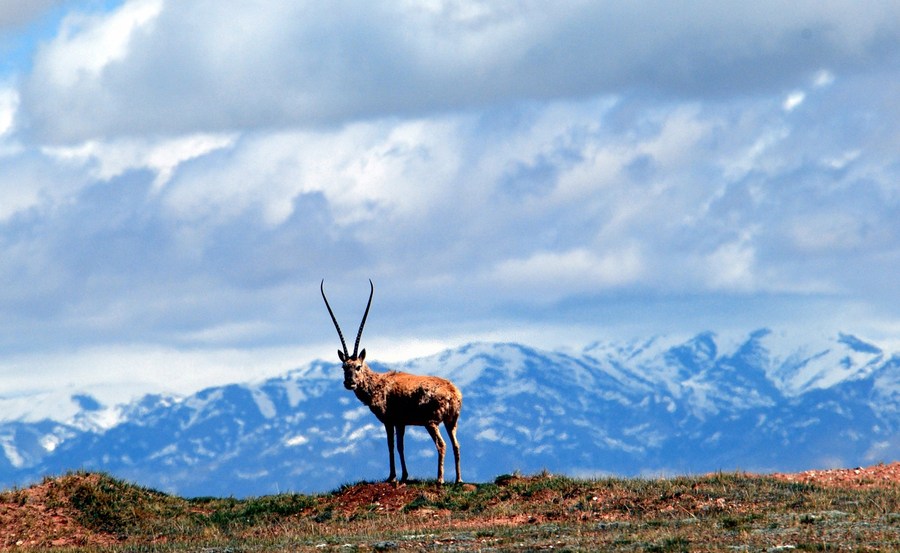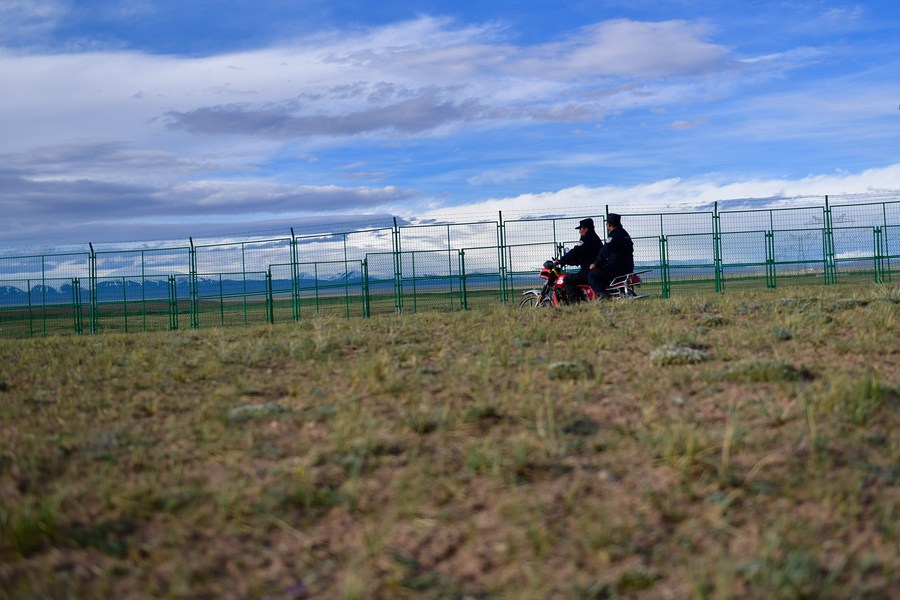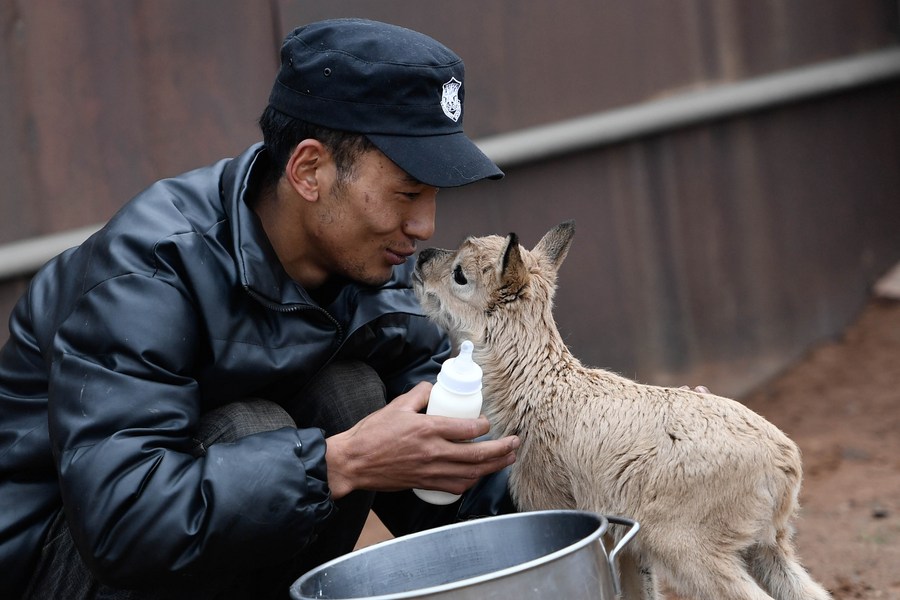 A Tibetan antelope in Hol Xil National Nature Reserve in northwest China's Qinghai Province. (Xinhua)
A Tibetan antelope in Hol Xil National Nature Reserve in northwest China's Qinghai Province. (Xinhua)
The Hoh Xil reserve encompasses China's largest area of uninhabited land, with an average altitude of more than 4,600 meters. It is home to several endangered species, including the Tibetan antelope, Tibetan gazelle and wild yak.
by Xinhua writer Geng Huihuang
XINING, July 17 (Xinhua) -- It is early morning, and there are grey clouds above the Hoh Xil National Nature Reserve in northwest China's Qinghai Province. Lhundrup Tsegyel looks up at the sky, thinking about the day's weather and what it might mean for his team's work.
Aged 31, Lhundrup Tsegyel is the deputy head of the Sonam Dargye Protection Station at Hoh Xil, and his work often takes him into the wilderness. His frequent exposure to the elements is evidenced by his tanned face. Standing in the yard of the station on this gloomy morning, he looks a little worried. "It seems we'll have a rough day," he whispers.
The Hoh Xil reserve covers 45,000 square kilometers, encompassing China's largest area of uninhabited land, with an average altitude of more than 4,600 meters. It is home to several endangered species, including the Tibetan antelope, Tibetan gazelle and wild yak.
Founded in 1997, the Sonam Dargye Protection Station takes a leading role in wildlife protection here, and now there are five protection stations on the reserve.
"When I arrived here, at the very beginning, most of my colleagues left because of the thinness of the air and the cold, as well as the lack of water, electricity and gas supplies," Lhundrup Tsegyel says.
Finishing breakfast, he hits the road with two teammates. After a bumpy, two-hour drive, they stop at a crossing.
 Lhundrup Tsegyel and his colleague on patrol in the Hol Xil National Nature Reserve, Qinghai Province, June 29, 2020. (Xinhua/Zhang Long)
Lhundrup Tsegyel and his colleague on patrol in the Hol Xil National Nature Reserve, Qinghai Province, June 29, 2020. (Xinhua/Zhang Long)
"If the tire tracks are fresh, we need to see whether there are trespassers. Although in recent years, illegal hunting has lessened, we can't drop our guard," Lhundrup Tsegyel says, squatting near the tracks.
In the 1980s, the area was beset by poachers who hunted Tibetan antelopes for their hide, which was made into expensive shahtoosh shawls. Each shawl, priced as high as 50,000 U.S. dollars, was made at the expense of the lives of three to five antelopes.
The Tibetan antelope population declined sharply through the 1980s, dropping from 200,000 to 20,000. Thanks to great efforts to improve its habitat, and a ban on illegal hunting, Hoh Xil is now home to more than 70,000 Tibetan antelopes. In July 2017, the reserve became a World Heritage Site.
Wang Wenhao, barely 20, is the youngest team member at the station. The lack of oxygen here has turned his lips blue, but he keeps a sharp eye on the tracks and listens intently to Lhundrup Tsegyel.
Wang has gained experience through patrolling, and is now well-acquainted with anti-poaching measures, emergency rescue, garbage collecting and other work. "I still have a long way to go," he says.
Just as Lhundrup Tsegyel predicted, there is indeed a downpour, the wind blowing grit and rain against the car windows.
"Don't fear. The storm will stop soon," says Lhundrup Tsegyel.
Once again, he is right. Shortly after, the storm disappears and the sun comes out. In the distance, some male Tibetan antelopes stand on the plain, looking around.
"That one was a lost baby antelope that we rescued in 2017," says Lhundrup Tsegyel. "I can't believe it's grown so fast!"
Every year, in May, pregnant Tibetan antelopes start to migrate to Hoh Xil to give birth, returning to their habitats with their babies around August.
During the migration journey, some baby antelopes fall behind and get separated from the herd. These are sent to the wildlife rescue center at the Sonam Dargye Protection Station. For this reason, the center has been called "the kindergarten of baby Tibetan antelopes," and the 14 staff there are thought of as "nannies."
 A staff member feeds milk to a Tibetan antelope baby at the Zonag Lake protection station in Hol Xil, northwest China's Qinghai Province, July 8, 2020. (Xinhua/Zhang Long)
A staff member feeds milk to a Tibetan antelope baby at the Zonag Lake protection station in Hol Xil, northwest China's Qinghai Province, July 8, 2020. (Xinhua/Zhang Long)
This year, the patrollers have rescued 11 baby Tibetan antelopes, some of which have already been sent to the center, while others will arrive soon. So far, more than 500 animals, including Tibetan antelopes, have been rescued.
"To take good care of the baby antelopes, we bottle-feed them with milk. Whenever some of them are weak and frightened, we even carry our bedding into their enclosures and sleep with them, just to give them a greater feeling of comfort," says Tsering Dorje, one of the team members.
Once the condition of the baby antelopes improves, they are taken to the grasslands and released into the wild.
"Although it's hard to say goodbye, we have to let them go. We can't bond with them too deeply. We need to prevent them from having excessive interactions with humans," Tsering Dorje says.
Back in the car, the men continue their daily patrol, tired but alert. Outside, the antelopes are wandering around peacefully, occasionally leaping into the air. They are charming and mysterious, but also fragile. ■



